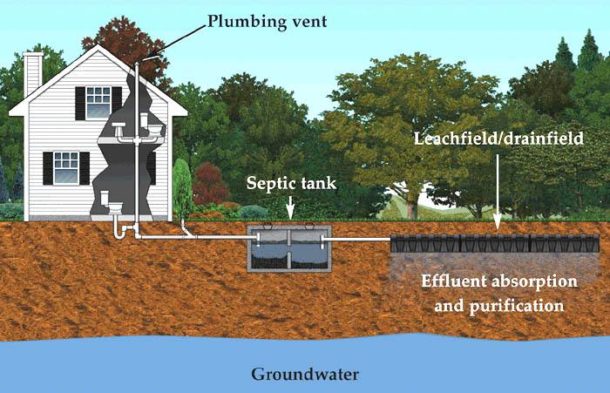When it comes to building a sustainable future, more residents and businesses are looking into different ways to do this. While yes, most folks will turn to smart home technology since these are energy efficient and are ideal for tracking energy and water use, this isn’t necessarily the only thing that’s being done. In fact, more homes and businesses have been opting for sustainable plumbing for their homes and commercial spaces, such as low-flow toilets, low-flow faucets, and other fixtures.
But with that said, however, while there are more and more options slowly growing for residents and commercial owners to choose from, even with plumbing, is it still enough? Specifically, one major question that’s been coming up, especially those in suburbs, tiny homes, and trailer parks, would be septic tanks. Are septic tanks actually sustainable, and can these help make plumbing more eco-friendly? Well, here’s everything you need to know!

Septic Tank Basics
So, before this can be a simple “yes” or “no,” you’re going to have to get a solid grasp of the basics first. Septic tank systems consist of two main components: the septic tank itself and a drain field. The septic tank is buried in the lawn and made of concrete, fiberglass, or even plastic.
It’s able to separate the solids and liquids, which can be seen as a good thing since municipal plumbing, like in a major city, usually doesn’t do that. Effluent in the tank is then released once there are layers in the tank (such as a layer for sludge and a layer for grease), and then the effluent gets into a drain field, which then gets filtered into the soil. This gives the chance for microorganisms to break down any contaminants that are left.
The Factors That Help Make Septic Tanks Sustainable
So, to simply put it, yes, septic tanks can be sustainable; while they’re not perfect, you can count on professional plumbers like Wade’s Plumbing & Septic to help you install them so your plumbing will be more sustainable. What exactly makes a septic tank sustainable?
There’s the Aspect of Natural Process
Septic tanks rely on natural processes for wastewater treatment. The anaerobic bacteria in the tank break down the solid waste, and the effluent undergoes further treatment as it percolates through the soil in the drain field (what was already mentioned earlier). To a degree, this natural treatment can be considered eco-friendly compared to more energy-intensive centralized wastewater treatment plants.
No Need for an Extensive Sewer System
They’re located on properties, so each home is going to get its own septic tank. This eliminates the need for extensive sewer infrastructure and reduces the energy required for pumping and transporting wastewater to centralized treatment facilities. But how exactly does this make a septic tank sustainable? While, again, they’re not 100% sustainable, what this at least means is that fewer resources will be used and few habitats will be damaged since it’s a small space that needs the septic tank to be installed rather than an extensive piece of land.
Less Energy Being Used
Central sewage systems, like those you find in cities, need a lot of energy; they’re not exactly sustainable. In order to be operated, energy has to be used, and septic tanks don’t need any of that. In fact, they operate just fine without any electricity in the slightest. Sometimes, a septic tank needs to be pumped, and there needs to be maintenance, but this is usually around once a decade at most, so this is extremely energy efficient.
Soil Filtration
When it comes to the the drain field, this is actually the component of septic systems that relies on soil filtration to further treat effluent. This was already briefly mentioned earlier, but this is what really helps out in making a septic tank such a unique plumbing system for homes. It’s the soil itself, specifically healthy soil, that acts as a natural filter.
The soil itself is actually able to remove impurities and pathogens from the water. This process contributes to groundwater recharge and can be considered environmentally beneficial when the soil has the capacity to effectively treat the effluent.
Water Conservation
A lot of homeowners, in particular, are switching to low-flow fixtures, and they’ll also even go as far as not flushing the toilet as much. These can be a good thing in the name of being more eco-friendly.
When it comes to septic tanks, homes will actually need to be cautious about their water use because it can lead to problems in the septic tank, like reduced treatment efficiency and potential environmental impact (such as the ground getting contaminated). So, for homes that want to conserve more water, you’re basically going to have no choice but to do this; if you have a septic tank, you’ll need to.
Biodiversity
Alright, so this one could actually be seen more as a mixed bag because there is a pro and con to it. Septic tanks do use soil filtration, and the soil itself is able to remove impurities, which then can turn into groundwater. Plus, the nutrients that are released can be good for vegetation, too. So, that’s a good thing, but this still isn’t perfect either. On the other hand, excessive nutrient loading may lead to imbalances, affecting local flora and fauna negatively. So it’s like a catch-22 where there are some perks, but at the same time, there are still some bad aspects to it.
Potential Concerns
Just above, you’ll see that while yes, a septic tank is good for the soil, at the same time, is can lead to an imbalance. But that’s not necessarily the only concern there is, though. They can have the ability to cause potential harm if they’re not being properly maintained either. Failing or poorly maintained systems may release untreated or partially treated wastewater; this will then get into the soil and even into the ground water.
While it’s true that the soil can help filter out the water, if there’s too much and if the tank isn’t be maintained like it should be, then it’s not going to get the job done, leading to pollution. So, in short, while a septic tank is sustainable (for the most part), if it’s not being maintained properly, than it’s no longer eco-friendly, but in fact, it’ll be damaged in the environment.




Join the conversation: